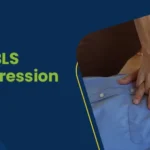Table of Contents:
- What is Choking?
- What Is The Heimlich Maneuver?
- When Does A Person Require Heimlich Maneuver?
- Heimlich Maneuver Steps
- How To Do the Heimlich Maneuver in Exceptional Cases?
- Precautions To Consider While Giving Heimlich Maneuver
- Significance Of Learning Heimlich Maneuver
People are prone to unpredictable injuries and accidents in everyday life. These emergencies could be physical discomfort, minor injuries, or large traumatic wounds. However, all these are dealt with differently, and the first aid provided in each of these situations is highly variable.
When choking occurs accidentally in adults by bites of food, it occurs in kids due to swallowing of foreign bodies. In either case, it must be taken care of immediately. The best-applied first aid approach in choking is the Heimlich maneuver. Dr. Heimlich claims that his maneuver has saved 100,000 people from choking. In this blog, we shall discuss all essential information about choking and the Heimlich maneuver.
Master ACLS Now
Get ACLS certified with confidence
What is Choking?
Choking can be defined as troubled breathing or difficulty in breathing that results from an obstruction in the throat or other parts of the airway. The obstruction that has resulted in choking could either be a piece of food or even a foreign object. Some of the most commonly choked food items include:
- Cherry tomatoes
- Chips
- Canned fruits
- Grapes
- Raw vegetable chunks
- Berries and cherries
- Toffees
- Corn kernels
- Hotdogs
Apart from these food items, a few objects are often swallowed and choked by kids and accidentally by adults, too.
- Coins
- Bottle caps
- Buttons
- Pebbles
- Batteries
- Parts of toys
- Pen caps
Signs of Choking
Choking, if left unattended, can result in a lack of oxygen in the blood. Subsequently, the lack of oxygen can cause brain damage, eventually leading to death within 4-6 minutes.
Here are the most common signs to look out for in suspected cases of choking. Expressing the following symptoms requires immediate attention and action.
- Squeaky sounds in efforts to breathe.
- Expression of Frantic, panic, shock or confusion.
- Either one or both hands clutched around the throat region.
- Inability to speak.
- Coughing with effort but weak or forceful.
- Strained or noisy breathing.
- Greyish or bluish discolouration in skin, lips and nails.
- Loss of consciousness.
What Is The Heimlich Maneuver?
The Heimlich maneuver is a first aid protocol carried out during events of choking. As choking can obstruct the throat or airway, the patient will face oxygen deficit in their blood, leading to brain death if left unattended.
The Heimlich maneuver helps clear the obstruction that has caused the breathing difficulty and thus helps restore the patient’s normal breath. Since this procedure involves thrusting the abdominal region, it is often referred to as an abdominal thrust. Hamlet maneuver is a rather informal name given to the same procedure.
Although it is used as a first aid measure for choking, it should only be used on those with full consciousness. It should be avoided in those with a lack of consciousness, as the condition can potentially worsen.
When Does A Person Require Heimlich Maneuver?
The Heimlich maneuver is applied to individuals who are undergoing choking. However, it should be applied only when choking results in a threat to the life of the individual. The person must be fully conscious to be eligible for this procedure.
The following category of individuals should be exempted from receiving the normal protocol of the Heimlich Maneuver. On the occurrence of life-threatening choking in these individuals, alternative or modified techniques should be given.
- Pregnant women,
- Infants below the age of 1 year,
- Elderly and individuals with weak health.
Unconscious individuals should be given CPR instead of the Heimlich Maneuver.
Read More: Basic airway management in adults.
Heimlich Maneuver Steps
The Heimlich maneuver should only be applied to conscious individuals. Ensure it by asking them if they are choking. If the person is able to cough or breathe despite choking, do not attempt the maneuver. Ask them to cough continuously until they expel the choked object.
In case they are unable to give a verbal answer, cough, or breathe but can only gasp, look out if they exhibit the universal choking sign, which is clutching their throat with their hands. The following steps explain how to give the Heimlich maneuver during choking.
- Secure a standing position behind the person who is choking.
- Wrap your arms, put your arms around the patient’s abdominal region or belly.
- Tightly clasp your one hand over the other to create a fist.
- Below the patient’s ribcage, the thumb side of your fist. This should be approximately two inches above the patient’s navel.
- Apply sharp and quick thrust using your hands in inward and upward directions 5 times.
- Repeat this process until the choked object dislodges from the person’s trachea.
- If the object doesn’t dislodge, repeat until the person turns unconscious and begin Cardiopulmonary resuscitation or CPR once they turn unconscious.
The above-stated method applies to individuals who do not fall under the exempted category. How to do the Heimlich maneuver or its modified techniques for exceptional cases shall be discussed below.
How To Do the Heimlich Maneuver in Exceptional Cases?
In exceptional cases where the person is conscious, the Heimlich maneuver is not recommended. Instead, modified techniques and thrusts are applied to each category of individuals. Some of such cases are:
- Pregnant Women and Obese Individuals: In such cases, you need to position yourself behind the individual and apply thrust on the chest instead of the abdominal area.
- Infants Below The Age of 1 Year: You need to follow the below-mentioned steps when an infant experiences choking:
- Hold the infant by facing it down along your forearm. With your other hand, support its head and neck.
- Apply 5 firm back blows between the infant’s shoulder blades using the heel of your hand.
- Gently turn the infant onto their back, ensuring you support their head and neck.
- Now, apply 5 quick chest thrusts using 2 fingers by placing them in the center of the baby’s chest, just below the nipple line.
- Repeat this alternatively until the object dislodges.
- Elderly Individuals: People in their 70s have weak bones and lower immunity. Thus, you should apply abdominal thrusts with minimal force, taking care of their ribs.
Read More: First Aid For An Unconscious Person
Precautions To Consider While Giving Heimlich Maneuver
Similar to any first aid provided in emergencies, there are a few factors to be cautious about while carrying out this procedure. Whether more or less time is available to perform the maneuver, precautions should be taken; otherwise, it can potentially cost a life. Ensure that all the precautions provided below are taken while carrying out the Heimlich maneuver.
- Confirm that the person is undergoing choking and not some other difficulty.
- Do the procedure only if the person’s life is in danger due to choking. However, if a Heimlich maneuver is needed, do not delay the process at any cost.
- Ensure that the patient is conscious. Applying the Heimlich maneuver on an unconscious person is prohibited.
- Don’t hit. Apply thrusts only.
- Do not apply force if the person is unable to cough. Doing so might cause the object to move deeper.
- Be mindful while dealing with elderly individuals, Individuals with osteoporosis-like conditions, pregnant women, and infants below the age of 1 year.
- Hand placement in obese individuals should be slightly closer to the chest than the abdomen.
- Avoid applying rigorous force, as performing the act incorrectly can result in serious intra-abdominal injury.
Final Thoughts
As the amount of oxygen delivered to the pulmonary system during choking is drastically reduced, so is the concentration of oxygen in blood carried across the body. Every second, there is a significant deficit in the amount of oxygen reaching the bodily tissues and the brain. This lack of oxygen and delay in its delivery can result in adverse effects on brain function.
Carrying out the Heimlich maneuver appropriately during an event of need helps restore proper breathing and, thereby, brain activity. However, to carry it out properly, one must be well trained and should know all necessary details like when to perform the Heimlich maneuver, its steps, and all precautions to be considered, etc. An immediate approach to this emergency by a trained individual thus helps avoid a mishap to the patient’s life.







